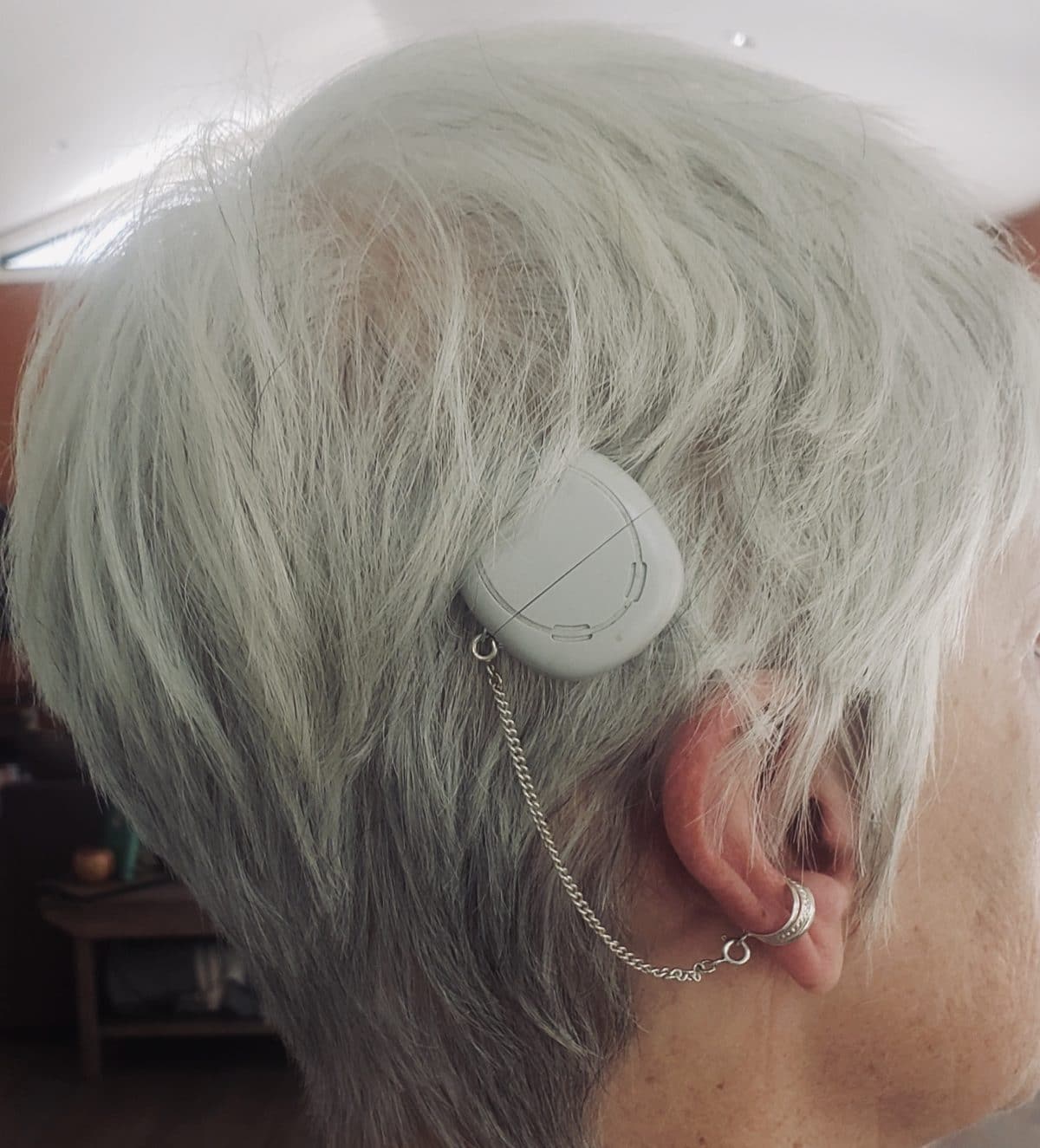Hearing aids have yet to reach the same level of high fashion as eyeglasses. But they’ve come a long, long way and so has public attitude towards them. But until recently, personal hearing technology was still big and ugly, which helped explain the distaste that people had for using them.
At least, that’s how I felt when I got my first hearing aid. In my eyes, it was a nauseous shade of beige – a solid and unwelcome presence behind my right ear. Even worse, my hair was short-ish, putting my hearing aid in full public view, beaming a message to all who saw it: “Hey, lookit here! Harda-hearing girl!”

Similar to my first hearing aid
I eventually made my peace with that one and a succession of others. I didn’t mind people knowing I had hearing loss – it was better than having them think I was stupid – but I didn’t see any reason to advertise the point. When I looked in the mirror, I couldn’t see my aid and that was the image I preferred to project. If someone was taking a picture of me, I gave face-forward or left-side views. And if I saw a photo of my right profile, the glint of hearing aid always surprised me, as if I was looking at a picture of someone else.
Two decades after getting that first beige boom-box, three things changed. One was a seismic shift caused by baby boomers reaching the hearing loss age. A new generation of people needing hearing aids wanted something better than the old style. At the same time, digital technology was exploding, offering people with hearing loss better sound, cleaner aesthetics and smaller size. Blah-blah-beige had given way to various shades of silver, blue, red, black, you-name-it. I happened to be due for a new hearing aid and I switched to two small – and absolutely adorable – c ompletely-in-the-canal (CIC) hearing aids. They not only helped me hear better but freed me up to do whatever I wanted with my hair.
ompletely-in-the-canal (CIC) hearing aids. They not only helped me hear better but freed me up to do whatever I wanted with my hair.
The third change was my new involvement in hearing loss advocacy. The people I met didn’t care whether their hearing aids showed or not – what was important was being able to hear better. In this new world, I lost any lingering wisps of shame I’d felt about displaying my disability. Or so I thought…
When it came time to get a cochlear implant (CI) a couple of years ago, I immediately gravitated to the smaller sound processor being offered by two of the CI companies. Rather than the behind-the-ear style of the traditional CI sound processor, Cochlear’s Kanso model sits on the head,  attached by a magnet with a safety line that clips to the hair or an article of clothing. But I learned, once again, that there’s a price to pay when vanity rules our decisions. If you try to hide something, it sometimes becomes more visible. At a function, a woman tried to whisper in my ear which never works for lipreaders like me, but she managed to get across that there was a black bug in my hair. The processor may not have been too noticeable, but the safety line was. (I’ve since learned to tuck it under my hair more efficiently.)
attached by a magnet with a safety line that clips to the hair or an article of clothing. But I learned, once again, that there’s a price to pay when vanity rules our decisions. If you try to hide something, it sometimes becomes more visible. At a function, a woman tried to whisper in my ear which never works for lipreaders like me, but she managed to get across that there was a black bug in my hair. The processor may not have been too noticeable, but the safety line was. (I’ve since learned to tuck it under my hair more efficiently.)
I also noticed that young adult members of the Canadian Hard of Hearing Association and passionate advocates for living well with their disability, were doing absolutely nothing to hide their hearing gear. They are walking the talk about not feeling embarrassed about hearing loss, whether it’s the devices we use or having to ask for repeats or fighting for communication access. They inspire me.
I once wrote that when I got a CI, I would wear feathers in my hair. I haven’t figured that out yet, but I’ve found a charming new type of safety line from The Hear Clip. I love the look of the funky ear cuff that attaches to my sound processor. There may be other companies out there that offer lovely enhancements to the beautiful devices that let us hear gorgeous sound. If so, please let us know! 
If you’ve got it, flaunt it! If that’s too much to ask, at least don’t try to hide it.
Photos: Hearing aids by Starkey, Zenith and Oticon. Kanso and safety line by Cochlear.







Joannival@aol.com
I never have tried to hide it. Having watched my father and my father-in-law refuse to deal with their hearing loss I determined that I would do what needed to be done when it was my turn to deal with it. I tell people what I need from them in order to be part of the conversation. I’m even known to take the aids out wherever I happen to be when changing batteries or to show the aids to someone.
Thank you, Gael, for your column. It’s always encouraging and I look forward to reading it.
LOVE IT!
Just got new earmolds, and they’re blue and yellow swirly patterns….kind of psychedelic.
Hello, how did you put your tether on the Kanso, did you make a hole in the processor?
Thank you for your reply
My email : kassoutun@hotmail.fr